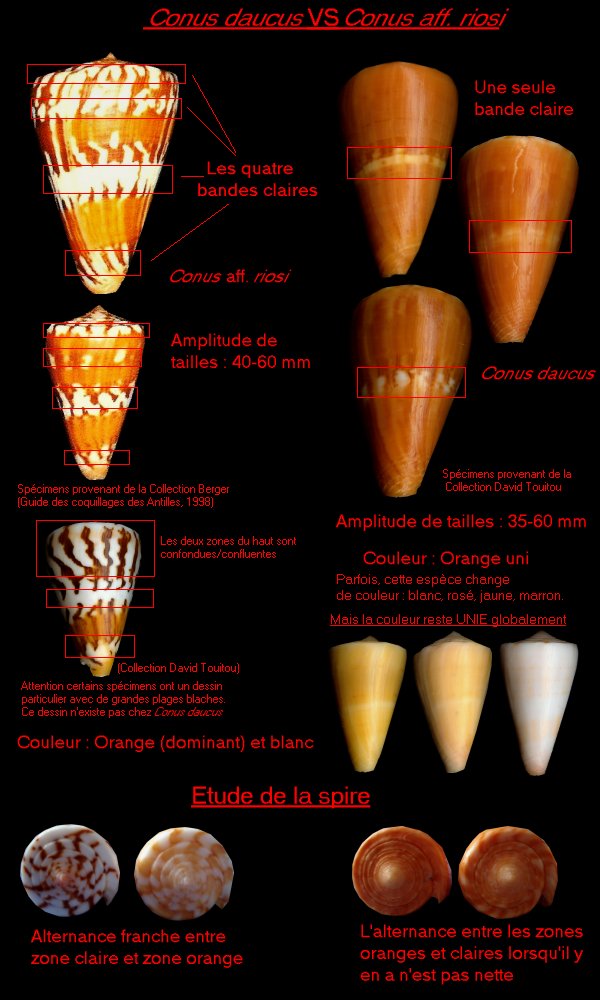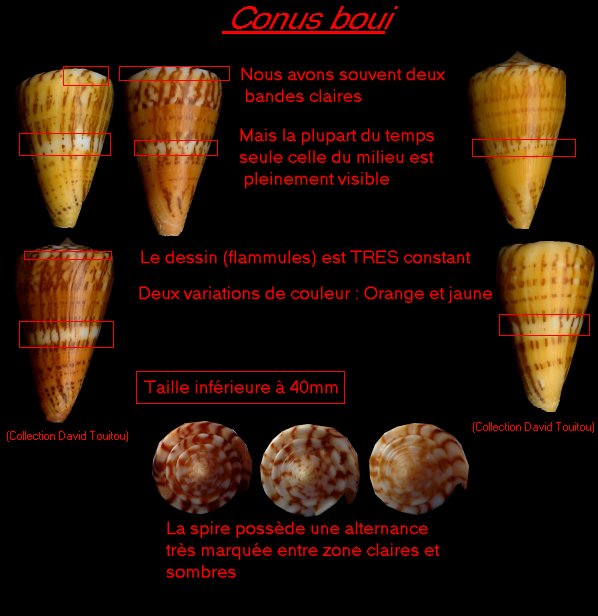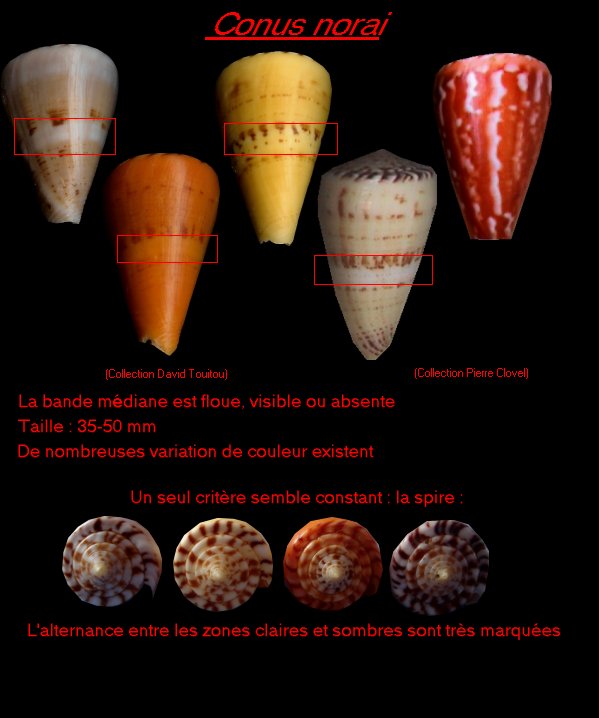Conidae From Martinique & Guadeloupe
![]()
Conidae From Martinique & Guadeloupe (2014)
By DAVID TOUITOU & JANINE JACQUES
First published : Touitou David, 2005
Last updated : 01-april 2018
Aknowledgments : Dominique Lamy, Bernard Duré, Pierre Clovel, Michael Tosato, Loic Limpalaër, Michael Tosato, John K Tucker
A few more species and new species from this area will be added to our work later (2014), after the publication of Dominique Lamy' Book.
Attenuiconus attenuatus Reeve, 1844
Rarity : rare
Size : 20-35 mm
Distribution : Martinique & Guadeloupe
|
|
|
|
|
|
|
|
Conus attenuatus
(Martinique) |
Conus attenuatus
(Guadeloupe) |
Conus attenuatus
(Guadeloupe) |
Conus attenuatus
(Martinique) |
Conus attenuatus
(Martinique) (2) |
|
(2) http://www.shellspassion.com
![]()
Dauciconus boui da Motta, 1988
Rarity : rare
Size : 20-40 mm
Distribution : Martinique
We consider it as a valid species. So much differences between both C. boui and C. daucus : Shell pattern, animal color, average size, deph, habitat are completely different between these species.We have collected both species live and assume totally our choice of level specie according to da Motta. It can be found during the daytime at deph from 10 to 40 meters hidding in grass and sand, often not burried, just laying. It seems more common in 25-35m. In Martinique, it have been found in the south caribbean coast only.
|
|
|
|
|
|
|
|
Conus boui
Orange variation (Martinique)
|
Conus boui
Orange variation (Martinique) |
Conus boui
Orange variation (Martinique) |
Conus boui
Yellow variation (Martinique) |
Conus boui
Yellow variation (Martinique) |
Conus boui
Holoype (**) (Martinique) |
(**) : Conus Biodiversity website Repository: MHNG Type Locality: Pte. de la Baleine, SW coast of Martinique. Photo Credit: Alan J. Kohn
![]()
Kohniconus centurio Born, 1778
Rarity : rare
Size : - mm
Distribution : Guadeloupe
Several populations occured in Guadeloupe by the past. Some have declined after Marilyn hurricane. It could be found between 8 and 15 meters.
|
|
|
|
|
|
|
|
Conus centurio
(St Barthélémy) |
Conus centurio
(St Barthélémy) |
Conus centurio
Holotype (**) |
|
|
|
(**) : Conus Biodiversity website Repository: NHMW Type Locality: Puerto Plata, Santo Domingo Photo Credit: Anita Eschne
![]()
Poremskiconus colombi (Monnier & Limpalaër, 2012)
Gradiconus burryae Clench, 1942
Rarity : common beached
Size : 15-30 mm
Distribution : Martinique
These small shells have been a real nightmare for collectors and malacologists. Before it was described (2012), this very local specie from Le Vauclin (Martinique) was sometime named as Conus burraye which is found in Florida, effectively it is close to this specie but it can be easily separated when you look carefully to the shells though (spire). Very recently it have been finally described as Conus colombi. Some collectors related these shells to Conus hennequini but they are clearly very different. I have found hundreds of empty shells in Le vauclin in sand patches between grass fields in 2-4 meters of water. Shells must live in this habitat and may be found during the night.
|
|
|
|
|
|
|
|
Conus colombi
(Martinique) |
Conus colombi
(Martinique) |
Conus colombi
(Martinique) |
Conus colombi
(Martinique) |
Conus colombi
(Martinique) |
Conus colombi
(Martinique) |
|
|
|
|
|
|
|
|
Conus colombi
Holotype (*) (Martinique) |
Conus colombi
Holotype (*) (Martinique) |
Conus burraye
Holotype (**) (Florida) |
|
Conus hennequini
Holotype (**) (Martinique) |
Conus hennequini
Holotype (**) (Martinique) |
|
|
|
|
|
|
|
|
Conus colombi
Paratype (*) (Martinique) |
Conus colombi
Paratype (*) (Martinique) |
Conus colombi
Paratype (*) (Martinique) |
Conus colombi
Paratype (*) (Martinique) |
|
|
(*) : in the courtesy of Loïc limpalaër
(**) : Conus Biodiversity website
![]()
Dauciconus daucus Hwass, 1792
Rarity : uncommon now
Size : 30-70 mm
Distribution : Martinique & Guadeloupe
This specie is very variable in color. Animal color may also vary. The most common color is the nice orange that gave its name as the "carrot's cone". Though, yellow, brown and white shells may be found too. The white ones may have also nice pink spots and sometime a pinkish overall color too. This shell may be found since the first meters hidden in rocky fissures often camouflated with it's "algae periostracum"; big gem specimens are difficult to find now.
|
|
|
|
|
|
|
|
Conus daucus
(Martinique) |
Conus daucus
(Martinique) |
Conus daucus
(Martinique) |
Conus daucus
(Martinique) |
Conus daucus
(Martinique) |
Conus daucus
Lectotype (**) |
(**) Conus Biodiversity website ( Representation of Lectotype of Conus daucus Hwass in Bruguière, 1792 Repository: Chemnitz (1788: pl. 144A, fig. L)
|
|
|
|
|
|
|
|
Conus daucus
(Martinique) |
Conus daucus
(Martinique) |
Conus daucus
(Martinique) |
Conus daucus
(Guadeloupe) |
Conus daucus
(Guadeloupe) |
|
![]()
Chelyconus ermineus Born, 1778
Rarity : actually probably disappeared from this area
Size :40-80 mm
Distribution : Martinique & Guadeloupe
While I was living in Martinique (2000-2002), it was really hard to find just like C. spurius. I only found fresh dead specimens in 10-20m. Among actually known species, probably the only piscivorous specie of the West Atlantic area. This specie used to be common in the past but for an unkkown (epidemic?) reason populations have declined in Martinique and Guadeloupe fastly years ago such as Conus spurius. Actually (2013) live shells have still not been collected anymore.
In Martinique, divers have seen (before year 2000) hundreds of empty fresh dead shells (south Martinique) in their diving spots, this tend to show that this specie have been decimated by some pollution, virus, bacteria, parasite ?
Divers (july 2014) have seen specimens of this specie in -40m in Guadeloupe.
|
|
|
|
|
|
|
| Conus ermineus (Martinique) |
Conus ermineus (Martinique) |
Conus ermineus (Guadeloupe) |
Conus ermineus (Martinique) |
Conus ermineus (Martinique) |
Conus ermineus
Lectotype (**) |
(**) : Conus Biodiversity website Repository: NHMW, Photo Credit: Alan J. Kohn, Type Locality: "Indiis," from Martini (1773)
![]()
Atlanticonus granulatus Linnaeus, 1758
Rarity : very rare
Size : 30-70 mm
Distribution : Martinique & Guadeloupe
This very nice and rare shell my be found deeply hidden in rocky crevices. I only found one empty shells in 5m of water in north Martinique (Carribean sea). Divers have found also some fresh dead specimens in 5-10m in south of Martinique (Caribbean sea). Specimens have been also found on the Atlantic side like the fift specimen shown (Guadeloupe).
|
|
|
|
|
|
|
| Conus granulatus (South Martinique) |
Conus granulatus (South Martinique) |
Conus granulatus (North Martinique) |
Conus granulatus Lectotype (**) |
Conus granulatus (N-E Guadeloupe) |
Conus granulatus
(South Martinique) |
(**) : Conus Biodiversity website Repository: LSL Type Locality: Jamaica Photo Credit: LSL (Linnean Society of London)
![]()
Purpuriconus hennequini Petuch, 1993
Rarity : ?
Size : mm
Distribution : Martinique
This shell is collected in a very rectricted area.
|
|
|
|
|
|
|
| Conus hennequini Holotype (**) (Martinique) |
Conus hennequini Holotype (**) (Martinique) |
|
(**) : Conus Biodiversity website Repository: MNHN Type Locality: La Vauclin, Martinique, French West Indies. Photo Credit: Alan J. Kohn
![]()
Dauciconus jacquescolombi (Monnier & Limpalaër, 2016)
Rarity : very rare
Size : 40-70 mm
Distribution : Martinique
This shell is very rare. I only found two empty shell in 40m of water. Though vey nice specimens have been found fresh dead by the past in Fort-de-France bay in moderately deep water (40-60m). It's a very nice shell and It may reach big sizes. Actually Conus riosi apply to Martinique populations bu also to other localities populations like the Brasil one. Some authors are actually describing this shell in order to be a new specie.
|
|
|
|
|
|
|
|
Conus riosi
(Martinique) |
Conus riosi
(Martinique) |
Conus riosi
Holotype (**) |
Conus riosi
(Martinique)
|
Conus riosi
(Martinique)
|
Conus riosi
(Martinique)
|
(**) Conus Biodiversity website Repository: MORG Type Locality: Salvador, Bahia State, Brazil; Trawled 50 m. Photo Credit: Paulo Màrcio Costa
![]()
Purpuriconus magellanicus Hwass in Bruguière, 1792
Rarity : Rare now
Size : mm
Distribution : Guadeloupe
This tiny specie may only be found in a restricted area and from 6 to 18 meters. It was found in less than 6 meters by the past but it have been overcollected by some at this depth.
|
|
|
|
|
|
|
| Conus magellanicus (Guadeloupe) |
Conus magellanicus (Guadeloupe) |
Conus magellanicus Lectotype (**) |
Conus magellanicus (Guadeloupe) |
|
(**) : Conus Biodiversity website Repository: MHNG Type Locality: Strait of Magellan [erroneous] Photo Credit: Alan J. Kohn
![]()
Dalliconus mazei Deshayes, 1874
Rarity : deep water specie
Size : 40 - 50mm
Distribution : Martinique & Guadeloupe
This deep water specie may be found from 90-100m of water.
|
|
|
|
|
|
|
| Conus mazei (Guadeloupe, -250m) |
Conus mazei (Guadeloupe, -250m) |
Conus mazei Holoype (**) |
Conus mazei Holoype (**) |
|
(**) : Conus Biodiversity website Repository: MNHN Type Locality: Martinique; 90 m Photo Credit: Alan J. Kohn
![]()
Jaspidiconus mindanus Hwass in Bruguière, 1792
Rarity : uncommon
Size : 10-30 mm
Distribution : Martinique & Guadeloupe
I found this species in 15m of water. It used to be easy to find by the past. This species may be found crawling on the sandy areas of the rocky shorelines at night. During the daytime it is buried in the sand patches.
|
|
|
|
|
|
|
| Conus mindanus (Martinique) |
Conus mindanus (Martinique) |
Conus mindanus (Martinique) |
Conus mindanus (Guadeloupe) |
Conus mindanus (Martinique) |
Conus mindanus
Lectotype (**) |
|
|
|
|
|
|
|
| Conus mindanus (Martinique) |
Conus mindanus (Martinique) |
Conus mindanus (Guadeloupe) |
|
(**) : Conus Biodiversity website Repository: MHNG Type Locality: N. of Nellies Point, South Lake Worth, Florida; 46 m Photo Credit: Alan J. Kohn
![]()
Gladioconus mus Hwass in Bruguière, 1792
Rarity : common to uncommon
Size : 20-50 mm
Distribution : Martinique & Guadeloupe
This is not a rare shell but is is hard to spot sometimes due to it's color. It lives usually in 1-10 meters of water along rocky shorelines in small crevices or under rocks.
|
|
|
|
|
|
|
|
Conus mus
(Martinique) |
Conus mus (Martinique) |
Conus mus
(Martinique) |
Conus mus
(Martinique) |
Conus mus
(Martinique) |
Conus mus
(Martinique) |
|
|
|
|
|
|
|
|
Conus mus
(Guadeloupe) |
Conus mus (Guadeloupe) |
Conus mus
Lectotype (**) |
Conus mus
Lectotype (**) |
|
|
(**) : Conus Biodiversity website Repository: MHNG Type Locality: Guadeloupe Photo Credit: Alan J. Kohn
![]()
Dauciconus norai da Motta & G. Raybaudi Massilia, 1992
Rarity : actually rare
Size : 30-60 mm
Distribution : Martinique
This shell is rarer than in the past. It seems to occur deeper that Conus daucus. Live shells usually come from 20-45 meters of water. Recent finds in Guadeloupe could extend the actual range of this supposed endemic specie.
|
|
|
|
|
|
|
|
Conus norai
(Martinique) |
Conus norai
(Martinique) |
Conus norai
(Martinique) |
Conus norai
(Martinique) |
Conus norai
(Martinique) |
Conus norai
Holotype (**) |
|
|
|
|
|
|
|
|
Conus norai
(Martinique) |
Conus norai
(Martinique) |
Conus norai
(Martinique) |
Conus norai
(Martinique) |
Conus norai
(Martinique) |
Conus norai
(Martinique) |
(**) Conus Biodiversity website Repository: MHNG Type Locality: Pte. de la Baleine, SW coast of Martinique. Photo Credit: Alan J. Kohn
![]()
Perplexiconus puncticulatus Hwass in Bruguière, 1792
Perplexiconus puncticulatus f. columba Hwass in Bruguière, 1792
Rarity : common
Size : 10-20 mm
Distribution : Martinique & Guadeloupe
This shell in commonly found on the Atlantic side, in 1m of water. If you swin in many beaches in Martinique, you may find hundreds of empty shells of C. puncticulatus and C. puncticulatus f. columba. They live in grass fields and sand patches. They bury in the sand during the daytime. Sometime (breeding season ?) they can be found grouped even during the daytime.
|
|
|
|
|
|
|
|
Conus puncticulatus
Lectotype (**) |
Conus puncticulatus
(Martinique) |
Conus puncticulatus
(Martinique) |
|
|
|
(**) Conus Biodiversity website Repository: MHNG Type Locality: Colón, Panama Photo Credit: Alan J. Kohn
|
|
|
|
|
|
|
|
Conus puncticulatus f. columba
(Guadeloupe) |
Conus puncticulatus f. columba
(Martinique) |
|
|
|
|
![]()
Jaspidiconus pusio Hwass in Bruguière, 1792
Jaspidiconus pusillus Lamarck, 1810
Rarity : uncommon
Size : 15-20 mm
Distribution : Martinique & Guadeloupe
The name Conus pusillus have been used since Vink have revealed that it was a synonym of Conus pusio earlier described (1792 versus 1810), that is the reason why the taxa to be actually used is Conus pusio Hwass, 1792
|
|
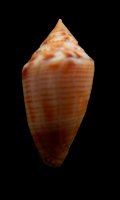 |
|
|
|
|
|
Conus pusio
(Martinique) |
Conus pusillus
Lectotype (**) |
Conus pusio
(guadeloupe) |
|
|
|
(**) Conus Biodiversity website Repository: MHNG Type Locality: Guinea [erroneous] Photo Credit: Alan J. Kohn
![]()
Stephanoconus regius Gmelin, 1791 & Conus citrinus Gmelin, 1791
Rarity : common
Size : 30-70 mm
Distribution : Martinique & Guadeloupe
This specie is commonly found from shallow water to 20-30 meters deep. It's feeding on the well known "fire-worm". This specie is very variable. We could say that every specimen is unique. In my opinion the best way to separate them is to arrange specimens in several color variations : the dark ones (overall dark brown pattren), the clear ones (overall clear pattern), the yellow and orange ones that I call "citrinus variation" and of course all the orthers that are intergrades between these three main pattern color variations. In 2000-2002 I sent a lot of samples for molecular research on this species and results have shown that there was only one specie. So for that reason the citrinus name must be used as a variation name only. The animal is clearly the same in all kind of variations. Conus regius can be found during daytime resting sided to huge rocks, in sandy crevices along the rocky shoreline. It may also burry like most cones. It can be foudn also crwling during the day time, usually around 16h00, before the end of the day.
![]()
(**) Conus Biodiversity website
Representation of Lectotype of Conus ammiralis regius Gmelin, 1791 Repository: Martini (1773: pl. 62, fig. 684)
Representation of Lectotype of Conus citrinus Gmelin, 1791 Repository: Martini (1773: pl. 61, fig. 681)
|
|
|
|
|
|
|
|
Conus regius
Clear variation (Martinique) |
Conus regius
Clear variation (Martinique) |
Conus regius
Clear variation (Martinique) |
Conus regius
Clear variation (Martinique) |
Conus regius
Clear variation (Martinique) |
Conus regius
Clear variation (Martinique) |
|
|
|
|
|
|
|
|
Conus regius
Dark variation (Martinique) |
Conus regius
Dark variation (Martinique) |
Conus regius
Dark variation
(Martinique) |
Conus regius
Dark variation (Martinique) |
Conus regius
Dark variation (Martinique) |
Conus regius
Dark variation
(Martinique) |
|
|
|
|
|
|
|
|
Conus regius
citrinus variation (Martinique) |
Conus regius
citrinus variation (Martinique) |
Conus regius
citrinus variation (Martinique) |
Conus regius
citrinus variation (Martinique) |
Conus regius
citrinus variation (Martinique) |
Conus regius
citrinus intergrade variation (Martinique) |
|
|
|
|
|
|
|
|
Conus regius
citrinus variation (Martinique) |
Conus regius
citrinus variation (Martinique) |
Conus regius
citrinus variation (Martinique) |
Conus regius
citrinus variation (Martinique) |
Conus regius
citrinus variation (Martinique) |
Conus regius
citrinus variation (Martinique) |
![]()
Lindaconus spurius Gmelin, 1791
Rarity : Rare now
Size : mm
Distribution : Martinique & Guadeloupe
While I was living in Martinique (2000-2002), it was really hard to find. I have nerver found a live specimen, only very old broken parts of shells. In Guadeloupe, live specimens may be hardly found from 5 to 10 meters in various habitats such as rubble and grass or near mangroves areas. This specie used to be common in the past but for an unkkown reason (epidemic?) populations have declined in Martinique and Guadeloupe fastly years ago such as Conus ermineus.
|
|
|
|
|
|
|
| Conus spurius (Martinique) |
Conus spurius (Guadeloupe) |
Conus spurius (Guadeloupe) |
Conus spurius (Guadeloupe) |
Conus spurius (Martinique) |
Conus spurius (Martinique) |
|
|
|
|
|
|
|
| Conus spurius (Guadeloupe) |
![]()
Jaspidiconus verrucosus Hwass, 1792
Jaspidiconus jaspideus f. verrucosus Hwass, 1792
Jaspidiconus jaspideus gmelin, 1791
Rarity :
Size : 15-20 mm
Distribution : Guadeloupe
Could be a subspecie of Conus jaspideus. Actually named as a form of Conus jaspideus by most authors.
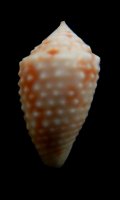 |
|
|
|
|
|
| Conus verrucosus (Guadeloupe) |
![]()

